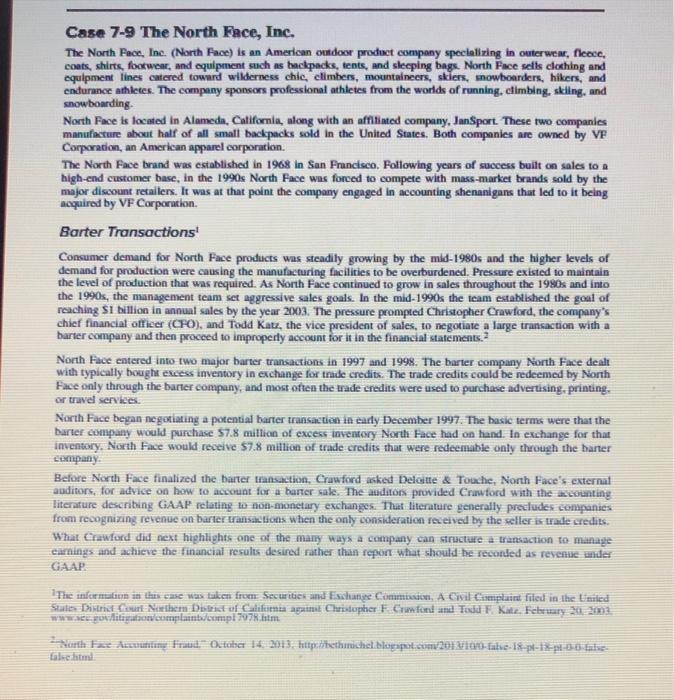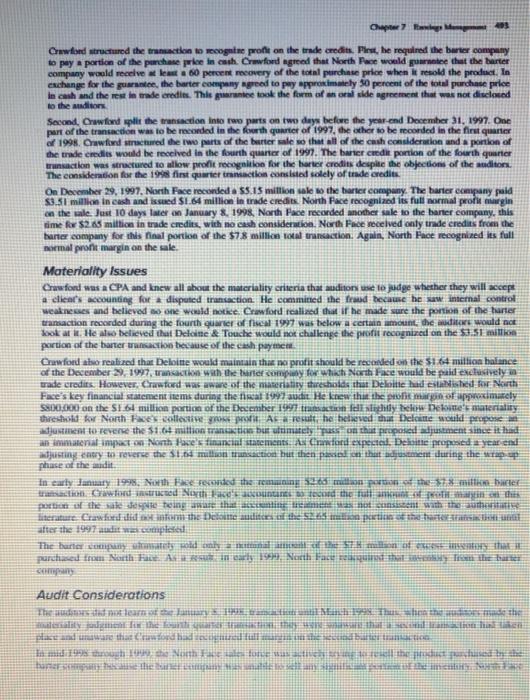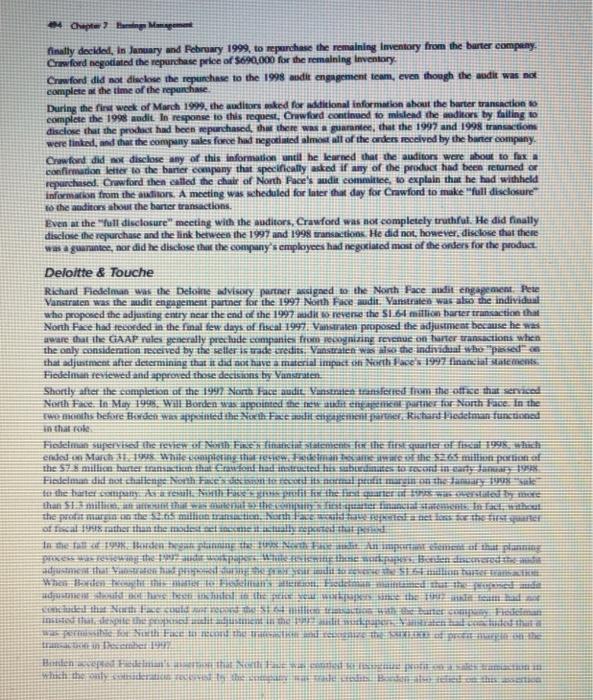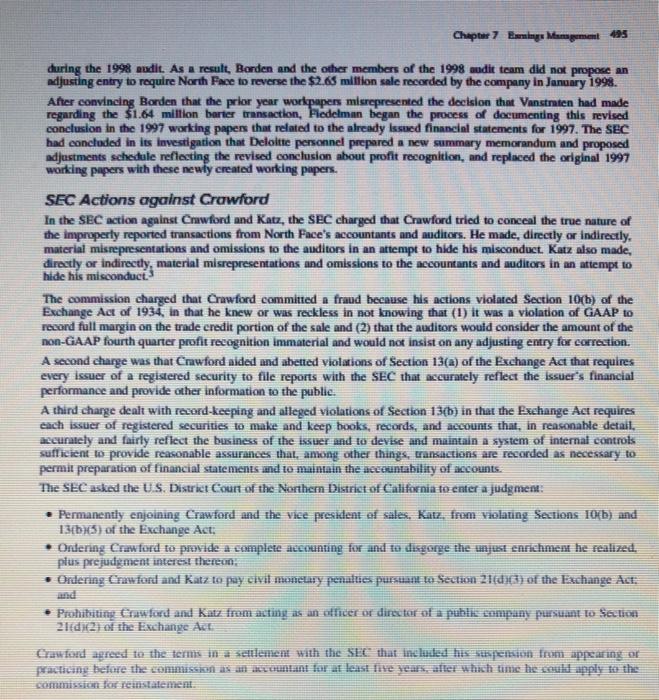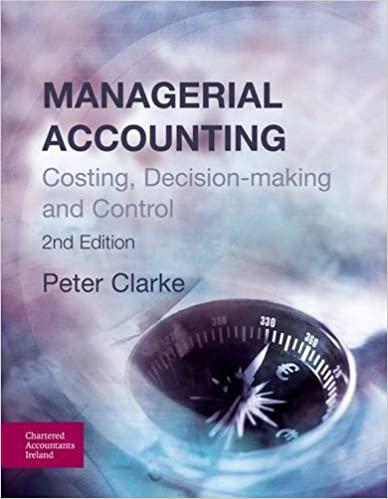Please read Case 7-9 from your textbook and answer the following questions: 1. Use the fraud triangle to analyze the red flags that existed in the case and the role and responsibilities of the auditors at Deloitte & Touche. Assume the Deloitte auditors had confronted Crawford about the impropriety of accounting for barter transactions. What reasons and rationalizations do you think would have been provided by Crawford? 2. Why do auditors have a responsibility to assess the key decisions made by management? Which decisions in this case should the auditors have scrutinized more carefully? Case 7-9 The North Face, Inc. The North Face, Inc. (North Face) is an American outdoor product company specializing in outerwear, fleece, coats, shirts, footwear, and equipment such as backpacks, tents, and sleeping bags. North Face ses clothing and equipment lines catered toward wilderness chic, climbers, mountaineers, skiers, snowboarders, hikers, and endurance athletes. The company sponsors professional athletes from the worlds of running, climbing, skiing, and snowboarding North Face is located in Alameda, California, along with an affiliated company, JanSport. These two companies manufacture about half of all small backpacks sold in the United States. Both companies are owned by VF Corporation, an American apparel corporation. The North Face brand was established in 1968 in San Francisco. Following years of success built on sales to high-end customer base, in the 1990s North Face was forced to compete with mass-market brands sold by the major discount retailers. It was at that point the company engaged in accounting shenanigans that led to it being acquired by VF Corporation. Barter Transactions! Consumer demand for North Face products was steadily growing by the mid-1980s and the higher levels of demand for production were causing the manufacturing facilities to be overburdened. Pressure existed to maintain the level of production that was required. As North Face continued to grow in sales throughout the 1980s and into the 1990s, the management team set aggressive sales goals. In the mid-1990s the team established the goal of reaching $1 billion in annual sales by the year 2003. The pressure prompted Christopher Crawford, the company's chief financial officer (CFO), and Todd Katz, the vice president of sales, to negotiate a large transaction with a barter company and then proceed to improperly account for it in the financial statements.? Nouh Face entered into two major barter transactions in 1997 and 1998. The barter company North Face dealt with typically bought excess inventory in exchange for trade credits. The trade credits could be redeemed by North Face only through the barter company, and most often the trade credits were used to purchase advertising, printing. or travel services. North Face began negotiating a potential barter transaction in early December 1997. The basic terms were that the barter company would purchase 57.8 million of excess inventory North Face had on hand. In exchange for that inventory. North Face would receive 57.8 million of trade credits that were redeemable only through the barter company Before North Face finalized the barter transaction, Crawford asked Deloitte & Touche, North Face's externat auditors, for advice on how to account for a barter sale. The auditors provided Crawford with the accounting literature describing GAAP relating to non monetary exchanges. That literature generally precludes companies from recognizing revenue on barter transaclicants when the only consideration received by the selleris trade credits. What Crawford did next highlights one of the many ways a company can structure a transaction to manage earnings and achieve the financial results desired rather than report what should be reconded as revenue wider GAAP The informulier in this case was taken from Securities and Exchange Commission, A Civil Complaint filed in the United Studio Distrit Couri Nchem District of Catilitzemta aguitat Christopher F.Crawford and Tischd . Kte. February 2012 Wolgatae cumplan compl 7978 sm Scirth Fae. Accrutiny Frutad. Otober 14, 2013 https:diethorichel.blogspot.com/201 Vio-labe-18-pk-1X-p4-30 tabs. falchtm Chapter 403 Crawford structured the transaction to recognize profit on the trade credits Pies, he required the barter company to pay a portion of the purchase price in cash Crawford agreed that North Face would goure that the barter company waeld receives a 60 percent recovery of the total purchase price when it resold the product. In exchange for the guarantee the barter company agreed to pay approximately 50 percent of the total purchase price In cash and the rest in trade credits. The garantee took the form of side agreement that was not disclosed to the audio Second, Crowford split the transaction into the parts on two days before the year and December 31, 1997. One part of the transaction was to be recorded in the fourth quarter of 1997, de other to be recorded in the first quarter of 1998. Crawford cured the two parts of the bunter sale so that all of the cash consideration and a portion of the trade credits would be received in the fourth quarter of 1997. The barter credit portion of the fourth quarter trunction was structured to allow profit recognition for the later crodits despite the objection of the auditon. The consideration for the 1998 first quarter traction consisted solely of trade credits On December 29, 1997. North Face reconded 55.15 million sale to the barter company. The baster company paid $3.51 million in cash and issued $1.64 million in trade credits North Face recognized is full normal pro margin on the wale. Just 10 days later on January 8, 1998, North Face recorded another sale to the barter company, this time for $285 million in trade credits, with no cash consideration North Face received only trade credits from the harter company for this real portion of the $7.8 million total transaction. Again, North Face recognized its full normal profit margin on the sale. Materiality Issues Crawfon was a CPA and knew all about the materiality criteria that suditors use to judge whether they will accept a client's accounting for a disputed transaction. He committed the red because he saw internal control weaknesses and believed she would notice. Crawford realized that if he made sure the portion of the arter transaction recorded during the fourth quarter of real 1997 was telow a certain amount the auditors would not Look at it. He also believed that Deloine & Touche would not challenge the profit recognized on the $9.51 milik portion of the barter transaction because of the cash payment Crawford abo realized that Deloitte would maintain that no profit should be recorded on the $1.44 million balance of the December 29, 1997 transaction with the parter som for which North Face would be paald exclusively a trade credits. However, Crawford was aware of the materiality storesholds that Deloitte hud ested for North Face's key financial statement items during the final 1991 audit He knew that the profit Migracimately SAD on the Sio million portion of the Elecember 1997 on fly helew Deloite materiality threshold for North Face collective of As a result teved that Deloitte would proponen et to reverse the $1.04 million transacties but ty that proposed adjustment an immaterial impact on North Face's financial statements. As ford expected Delisitte proposed a year end adjusting entry to reverse the sind mullion transaction but then paded on that adjustment during the WTA SE phase of the midit In early January 1998, North Facended the coming to mulaan porn the Smith mat Crawford strike Nous second the tulla till the portion of the said thing aware that are was not asistent with the author literature Crawfordulin the Deloitte auditor the Son pertinet after the 1997 audi cepleie The hurlemad on all the common of purchased from North Face. As in early 1999. Neith Face Targundy Tisen the batter Audit Considerations This means that the heat and the sity and then the link bet place and answare that cartod had conued to bure G In 1998 tohohote me the pictured by the The scheint 4 Chapter 7 haring Moment finally decided. In January and February 1999, to purchase the remaining Inventory from the barter company Crawford negotiated the repurchase price of $690.000 for the remaining Inventory Crawford did not disclose the repurchase to the 1998 and engagement team, even though the audit was not complete at the time of the repurchase During the first week of March 1999, the auditors asked for additional information about the barter transaction complete the 1998 audit . In response to this request. Crawford continued to mislead the dites by failing to disclose that the product had been purchased that there was a guarantee that the 1997 and 1998 transaction were linked, and that the company salesforce had negotiated almost all of the orders received by the bunter company Crawford did ww disclose any of this information until he learned that the auditors were about to fux confirmation letter to the baner company that specifically asked if any of the proces had been returned or repurchased. Crawford then called the chair of North Face's audit committee, to explain that he had withheld Information from the autor. A meeting was scheduled for later that day for Crawford to make "full disclosure to the audio sou the barter transactions Even at the full disclosure" meeting with the auditors, Crawford was not completely truthful. He did finally disclose the purchase and the link between the 1997 and 1998 transactions. He did not, however, disclose that there was a guarantee, nor did he disclose that the company's employees had negotiated most of the orders for the product Deloitte & Touche Richard Fiedeman was the Detome visory partner assigned to the North Face audit engagement Pere Vanstraten was the audit engagement partner for the 1997 North Face audit. Yaniraten was also the individual who proposed the adjusting entry near the end of the 1997 dit reverse the S1.6 million barter transaction that North Face had recorded in thermal few days of fiscal 1997. Vilten proposed the adjustment because he aware that the GAAP rufes generally preclude companies from recognizing reise - arter transactions when the only consideration received by the setter is trade credits. Vanstraten was also the individual who passet that adjustment after determining that it did not have a material impact thace's 1997 financial statement Hiedeltiltteriewed and approved those decisions by Vanstraten Shortly after the completion of the 1997. North Face audit. Vanematen taid the office that serviced Nur Fiet. la Many 1996. Will Borden was appointed the mette North Face. In the e Bebe Bande pitted the Fasadigital partner Bachari Hedelman functioned Fiesta Super Estantementelle fits quiler el local 1996 e Max Weingarten 263 million peo the 52 million barter transaction then had Findeman did not challenge North the January furtheater am reu than Stem In fact that the patut marine the 12.05 tanto the of fiscal 95% rather than the la 1998 in the Anmuthu theid th Berdin decret adju SE in to the ad the the North Face au Institucile that it ustment in th Surth End the These Binen Which the only cerca de ht Chapter 7 Einge Management 495 during the 1998 audit. As a result, Borden and the other members of the 1998 audit team did not propose an adjusting entry to require North Face to reverse the $2.65 million sale recorded by the company in January 1998. After convincing Borden that the prior year workpopers misrepresented the decision that Vanstraten had made regarding the $1.64 million barter transaction, Fedelman began the process of documenting this revised conclusion in the 1997 working papers that related to the already Issued financial statements for 1997. The SEC had concluded in its investigation that Deloitte personnel prepared a new summary memorandum and proposed adjustments schedule reflecting the revised conclusion about profit recognition, and replaced the original 1997 working papers with these newly created working papers. SEC Actions against Crowford In the SEC action against Crwford and Katz, the SEC charged that Crawford tried to conceal the true nature of the improperty reported transactions from North Face's accountants and auditors. He made, directly or indirectly material misrepresentations and omissions to the auditors in an attempt to hide his misconduct. Katz also made, directly or indirectly, material misrepresentations and omissions to the necountants and auditors in an attempt to hide his misconduct The commission charged that Crawford committed a fraud because his actions violated Section 10(b) of the Exchange Act of 1934, in that he knew or Wils reckless in not knowing that (1) it was a violation of GAAP to record full margin on the trade credit portion of the sale and (2) that the auditors would consider the amount of the non-GAAP fourth quarter profit recognition immaterial and would not insist on any adjusting entry for correction A second charge was that Crawford aided and abetted violations of Section 13(a) of the Exchange Act that requires every issuer of a registered security to file reports with the SEC that accurately reflect the issuer's financial performance and provide other information to the publie. A third charge dealt with record-keeping and alleged violations of Section 13(b) in that the Exchange Act requires each issuer of registered securities to make and keep books, records, and accounts that, in reasonable detail. accurately and fairly reflect the business of the issuer and to devise and maintain a system of internal controls sufficient to provide reasonable assurances that, ang other things, transactions are recorded as necessary to permit preparation of financial statements and to maintain the accountability of accounts. The SEC asked the US District Court of the Northern District of California to enter a judgment: Permanently enjoining Crawford and the vice president of sales, Katz. from vaolaring Sections 10%b) and 13:3) of the Exchange Act: Ontering Crawford to provide a complete accounting for and to disgorge the unjust enrichment he realized. plus prejudgment interest there. Ordering Crawford and Katz to pay civil memely penalties pursuant to Sectan 210c) of the Exchange Act und Prodututing Crawford and Katz from acting as an allicer of director of a public company pursuant to Section 2140:2) of the Exchange Act Crawford agreed to the terms in = selllement with the SEC that included his superion om appearing or practicing before the commission as an intentant for at least five years, after which time he could apply to the commission for reinstatement. Please read Case 7-9 from your textbook and answer the following questions: 1. Use the fraud triangle to analyze the red flags that existed in the case and the role and responsibilities of the auditors at Deloitte & Touche. Assume the Deloitte auditors had confronted Crawford about the impropriety of accounting for barter transactions. What reasons and rationalizations do you think would have been provided by Crawford? 2. Why do auditors have a responsibility to assess the key decisions made by management? Which decisions in this case should the auditors have scrutinized more carefully? Please read Case 7-9 from your textbook and answer the following questions: 1. Use the fraud triangle to analyze the red flags that existed in the case and the role and responsibilities of the auditors at Deloitte & Touche. Assume the Deloitte auditors had confronted Crawford about the impropriety of accounting for barter transactions. What reasons and rationalizations do you think would have been provided by Crawford? 2. Why do auditors have a responsibility to assess the key decisions made by management? Which decisions in this case should the auditors have scrutinized more carefully? Case 7-9 The North Face, Inc. The North Face, Inc. (North Face) is an American outdoor product company specializing in outerwear, fleece, coats, shirts, footwear, and equipment such as backpacks, tents, and sleeping bags. North Face ses clothing and equipment lines catered toward wilderness chic, climbers, mountaineers, skiers, snowboarders, hikers, and endurance athletes. The company sponsors professional athletes from the worlds of running, climbing, skiing, and snowboarding North Face is located in Alameda, California, along with an affiliated company, JanSport. These two companies manufacture about half of all small backpacks sold in the United States. Both companies are owned by VF Corporation, an American apparel corporation. The North Face brand was established in 1968 in San Francisco. Following years of success built on sales to high-end customer base, in the 1990s North Face was forced to compete with mass-market brands sold by the major discount retailers. It was at that point the company engaged in accounting shenanigans that led to it being acquired by VF Corporation. Barter Transactions! Consumer demand for North Face products was steadily growing by the mid-1980s and the higher levels of demand for production were causing the manufacturing facilities to be overburdened. Pressure existed to maintain the level of production that was required. As North Face continued to grow in sales throughout the 1980s and into the 1990s, the management team set aggressive sales goals. In the mid-1990s the team established the goal of reaching $1 billion in annual sales by the year 2003. The pressure prompted Christopher Crawford, the company's chief financial officer (CFO), and Todd Katz, the vice president of sales, to negotiate a large transaction with a barter company and then proceed to improperly account for it in the financial statements.? Nouh Face entered into two major barter transactions in 1997 and 1998. The barter company North Face dealt with typically bought excess inventory in exchange for trade credits. The trade credits could be redeemed by North Face only through the barter company, and most often the trade credits were used to purchase advertising, printing. or travel services. North Face began negotiating a potential barter transaction in early December 1997. The basic terms were that the barter company would purchase 57.8 million of excess inventory North Face had on hand. In exchange for that inventory. North Face would receive 57.8 million of trade credits that were redeemable only through the barter company Before North Face finalized the barter transaction, Crawford asked Deloitte & Touche, North Face's externat auditors, for advice on how to account for a barter sale. The auditors provided Crawford with the accounting literature describing GAAP relating to non monetary exchanges. That literature generally precludes companies from recognizing revenue on barter transaclicants when the only consideration received by the selleris trade credits. What Crawford did next highlights one of the many ways a company can structure a transaction to manage earnings and achieve the financial results desired rather than report what should be reconded as revenue wider GAAP The informulier in this case was taken from Securities and Exchange Commission, A Civil Complaint filed in the United Studio Distrit Couri Nchem District of Catilitzemta aguitat Christopher F.Crawford and Tischd . Kte. February 2012 Wolgatae cumplan compl 7978 sm Scirth Fae. Accrutiny Frutad. Otober 14, 2013 https:diethorichel.blogspot.com/201 Vio-labe-18-pk-1X-p4-30 tabs. falchtm Chapter 403 Crawford structured the transaction to recognize profit on the trade credits Pies, he required the barter company to pay a portion of the purchase price in cash Crawford agreed that North Face would goure that the barter company waeld receives a 60 percent recovery of the total purchase price when it resold the product. In exchange for the guarantee the barter company agreed to pay approximately 50 percent of the total purchase price In cash and the rest in trade credits. The garantee took the form of side agreement that was not disclosed to the audio Second, Crowford split the transaction into the parts on two days before the year and December 31, 1997. One part of the transaction was to be recorded in the fourth quarter of 1997, de other to be recorded in the first quarter of 1998. Crawford cured the two parts of the bunter sale so that all of the cash consideration and a portion of the trade credits would be received in the fourth quarter of 1997. The barter credit portion of the fourth quarter trunction was structured to allow profit recognition for the later crodits despite the objection of the auditon. The consideration for the 1998 first quarter traction consisted solely of trade credits On December 29, 1997. North Face reconded 55.15 million sale to the barter company. The baster company paid $3.51 million in cash and issued $1.64 million in trade credits North Face recognized is full normal pro margin on the wale. Just 10 days later on January 8, 1998, North Face recorded another sale to the barter company, this time for $285 million in trade credits, with no cash consideration North Face received only trade credits from the harter company for this real portion of the $7.8 million total transaction. Again, North Face recognized its full normal profit margin on the sale. Materiality Issues Crawfon was a CPA and knew all about the materiality criteria that suditors use to judge whether they will accept a client's accounting for a disputed transaction. He committed the red because he saw internal control weaknesses and believed she would notice. Crawford realized that if he made sure the portion of the arter transaction recorded during the fourth quarter of real 1997 was telow a certain amount the auditors would not Look at it. He also believed that Deloine & Touche would not challenge the profit recognized on the $9.51 milik portion of the barter transaction because of the cash payment Crawford abo realized that Deloitte would maintain that no profit should be recorded on the $1.44 million balance of the December 29, 1997 transaction with the parter som for which North Face would be paald exclusively a trade credits. However, Crawford was aware of the materiality storesholds that Deloitte hud ested for North Face's key financial statement items during the final 1991 audit He knew that the profit Migracimately SAD on the Sio million portion of the Elecember 1997 on fly helew Deloite materiality threshold for North Face collective of As a result teved that Deloitte would proponen et to reverse the $1.04 million transacties but ty that proposed adjustment an immaterial impact on North Face's financial statements. As ford expected Delisitte proposed a year end adjusting entry to reverse the sind mullion transaction but then paded on that adjustment during the WTA SE phase of the midit In early January 1998, North Facended the coming to mulaan porn the Smith mat Crawford strike Nous second the tulla till the portion of the said thing aware that are was not asistent with the author literature Crawfordulin the Deloitte auditor the Son pertinet after the 1997 audi cepleie The hurlemad on all the common of purchased from North Face. As in early 1999. Neith Face Targundy Tisen the batter Audit Considerations This means that the heat and the sity and then the link bet place and answare that cartod had conued to bure G In 1998 tohohote me the pictured by the The scheint 4 Chapter 7 haring Moment finally decided. In January and February 1999, to purchase the remaining Inventory from the barter company Crawford negotiated the repurchase price of $690.000 for the remaining Inventory Crawford did not disclose the repurchase to the 1998 and engagement team, even though the audit was not complete at the time of the repurchase During the first week of March 1999, the auditors asked for additional information about the barter transaction complete the 1998 audit . In response to this request. Crawford continued to mislead the dites by failing to disclose that the product had been purchased that there was a guarantee that the 1997 and 1998 transaction were linked, and that the company salesforce had negotiated almost all of the orders received by the bunter company Crawford did ww disclose any of this information until he learned that the auditors were about to fux confirmation letter to the baner company that specifically asked if any of the proces had been returned or repurchased. Crawford then called the chair of North Face's audit committee, to explain that he had withheld Information from the autor. A meeting was scheduled for later that day for Crawford to make "full disclosure to the audio sou the barter transactions Even at the full disclosure" meeting with the auditors, Crawford was not completely truthful. He did finally disclose the purchase and the link between the 1997 and 1998 transactions. He did not, however, disclose that there was a guarantee, nor did he disclose that the company's employees had negotiated most of the orders for the product Deloitte & Touche Richard Fiedeman was the Detome visory partner assigned to the North Face audit engagement Pere Vanstraten was the audit engagement partner for the 1997 North Face audit. Yaniraten was also the individual who proposed the adjusting entry near the end of the 1997 dit reverse the S1.6 million barter transaction that North Face had recorded in thermal few days of fiscal 1997. Vilten proposed the adjustment because he aware that the GAAP rufes generally preclude companies from recognizing reise - arter transactions when the only consideration received by the setter is trade credits. Vanstraten was also the individual who passet that adjustment after determining that it did not have a material impact thace's 1997 financial statement Hiedeltiltteriewed and approved those decisions by Vanstraten Shortly after the completion of the 1997. North Face audit. Vanematen taid the office that serviced Nur Fiet. la Many 1996. Will Borden was appointed the mette North Face. In the e Bebe Bande pitted the Fasadigital partner Bachari Hedelman functioned Fiesta Super Estantementelle fits quiler el local 1996 e Max Weingarten 263 million peo the 52 million barter transaction then had Findeman did not challenge North the January furtheater am reu than Stem In fact that the patut marine the 12.05 tanto the of fiscal 95% rather than the la 1998 in the Anmuthu theid th Berdin decret adju SE in to the ad the the North Face au Institucile that it ustment in th Surth End the These Binen Which the only cerca de ht Chapter 7 Einge Management 495 during the 1998 audit. As a result, Borden and the other members of the 1998 audit team did not propose an adjusting entry to require North Face to reverse the $2.65 million sale recorded by the company in January 1998. After convincing Borden that the prior year workpopers misrepresented the decision that Vanstraten had made regarding the $1.64 million barter transaction, Fedelman began the process of documenting this revised conclusion in the 1997 working papers that related to the already Issued financial statements for 1997. The SEC had concluded in its investigation that Deloitte personnel prepared a new summary memorandum and proposed adjustments schedule reflecting the revised conclusion about profit recognition, and replaced the original 1997 working papers with these newly created working papers. SEC Actions against Crowford In the SEC action against Crwford and Katz, the SEC charged that Crawford tried to conceal the true nature of the improperty reported transactions from North Face's accountants and auditors. He made, directly or indirectly material misrepresentations and omissions to the auditors in an attempt to hide his misconduct. Katz also made, directly or indirectly, material misrepresentations and omissions to the necountants and auditors in an attempt to hide his misconduct The commission charged that Crawford committed a fraud because his actions violated Section 10(b) of the Exchange Act of 1934, in that he knew or Wils reckless in not knowing that (1) it was a violation of GAAP to record full margin on the trade credit portion of the sale and (2) that the auditors would consider the amount of the non-GAAP fourth quarter profit recognition immaterial and would not insist on any adjusting entry for correction A second charge was that Crawford aided and abetted violations of Section 13(a) of the Exchange Act that requires every issuer of a registered security to file reports with the SEC that accurately reflect the issuer's financial performance and provide other information to the publie. A third charge dealt with record-keeping and alleged violations of Section 13(b) in that the Exchange Act requires each issuer of registered securities to make and keep books, records, and accounts that, in reasonable detail. accurately and fairly reflect the business of the issuer and to devise and maintain a system of internal controls sufficient to provide reasonable assurances that, ang other things, transactions are recorded as necessary to permit preparation of financial statements and to maintain the accountability of accounts. The SEC asked the US District Court of the Northern District of California to enter a judgment: Permanently enjoining Crawford and the vice president of sales, Katz. from vaolaring Sections 10%b) and 13:3) of the Exchange Act: Ontering Crawford to provide a complete accounting for and to disgorge the unjust enrichment he realized. plus prejudgment interest there. Ordering Crawford and Katz to pay civil memely penalties pursuant to Sectan 210c) of the Exchange Act und Prodututing Crawford and Katz from acting as an allicer of director of a public company pursuant to Section 2140:2) of the Exchange Act Crawford agreed to the terms in = selllement with the SEC that included his superion om appearing or practicing before the commission as an intentant for at least five years, after which time he could apply to the commission for reinstatement. Please read Case 7-9 from your textbook and answer the following questions: 1. Use the fraud triangle to analyze the red flags that existed in the case and the role and responsibilities of the auditors at Deloitte & Touche. Assume the Deloitte auditors had confronted Crawford about the impropriety of accounting for barter transactions. What reasons and rationalizations do you think would have been provided by Crawford? 2. Why do auditors have a responsibility to assess the key decisions made by management? Which decisions in this case should the auditors have scrutinized more carefully

